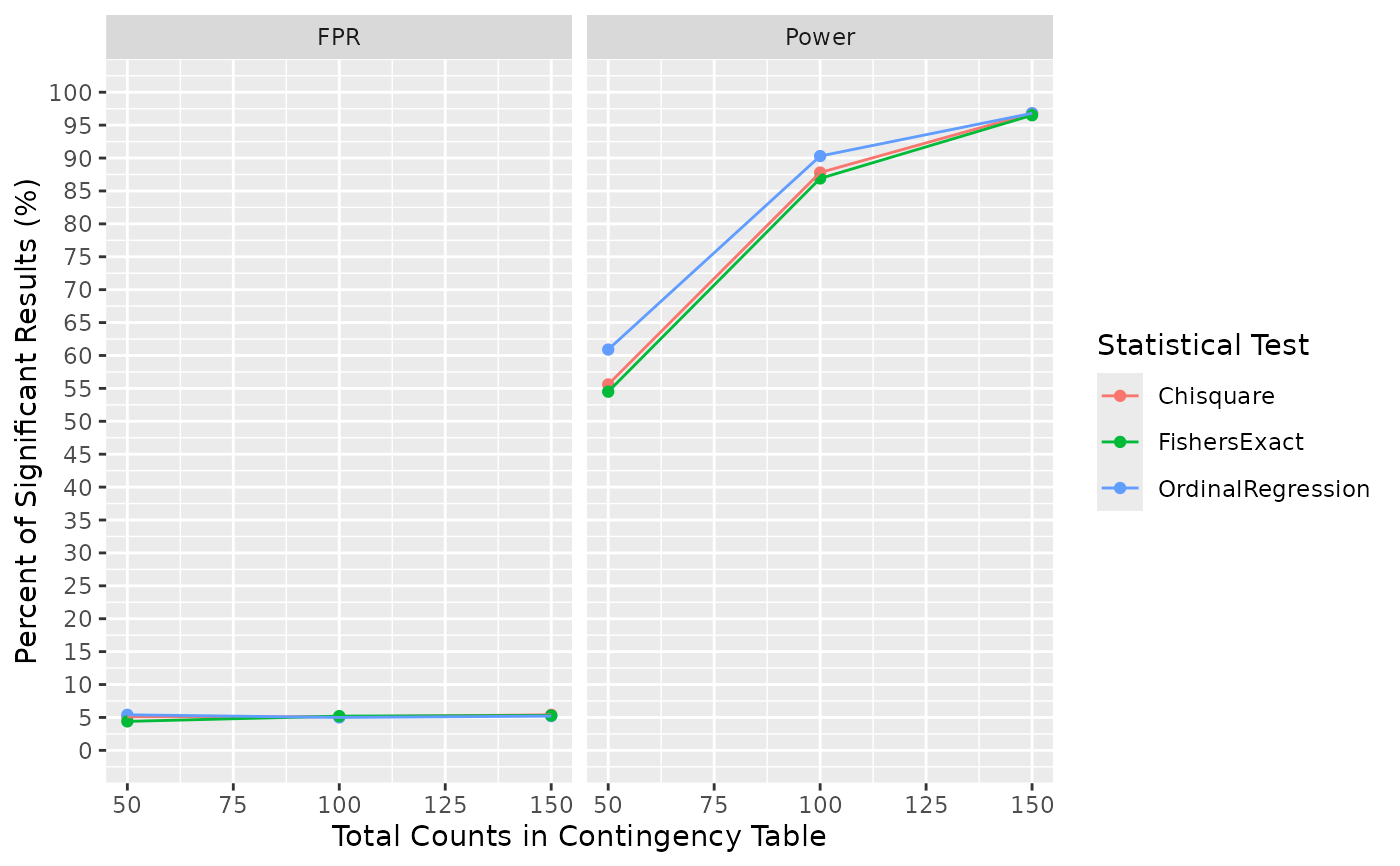Computes statistical power and optionally false positive rates for tests applied to contingency tables based on simulations. Specify the simulation process using Con_Simul(), which serves as input. Positive rates are computed for the Chi-square test and optionally for Fisher's exact test and the Wald test applied to an ordinal regression model.
Usage
Con_Simul_PR(
Con_Simul_Object = Con_Simul(),
add_fisher_exact = FALSE,
add_ord = FALSE,
sample_sizes = NULL,
n_sim = 1000,
FPR = TRUE
)Arguments
- Con_Simul_Object
Output from
Con_Simul()with the argumentverboseset to TRUE.- add_fisher_exact
Whether to compute positive rates for Fisher's Exact test. May add >1 min of calculation time. Defaults to FALSE.
- add_ord
Whether to compute positive rates for Wald test on a fitted ordinal regression model. May add >1 min of calculation time. Defaults to FALSE.
- sample_sizes
A vector of sample sizes over which false positive rates are to be calculated. A sample size is defined as the total number of counts in a contingency table. Defaults to total count received by
Con_Simul_Object.- n_sim
Number of contingency tables simulated for each positive rate calculation. Defaults to 1000.
- FPR
Whether to calculate false positive rate in addition to power. Defaults to TRUE.
Value
Returns a list containing:
pos_rate | A dataframe containing positive rates of various tests at specified sample sizes | |
eff_mat | The probability matrix used to calculate power | |
null_mat | The probability matrix used to calculate false positive rate | |
plot | A plot of positive rates of various tests at specified sample sizes |
Details
Power is defined as the percentage of tests yielding positive results (p-value < 0.05) on a set of contingency tables simulated based on the data-generating process and probability matrix specified in Con_Simul(). The specified probability matrix should represent the parameters of the population where there is a desire to detect a significant effect in the sample. The simulated contingency tables then reflect the sample outcomes of the specified population parameter.
False Positive Rate is defined as the percentage of tests yielding positive results (p-value < 0.05) on contingency tables simulated based on a probability matrix without treatment effect. The odd ratios between lesion scores for all treatment groups are assumed to be the same as that for control (first row in the probability matrix).
P-values for the Chi-square test are computed using stats::chisq.test() with default parameters. P-values for Fisher's exact test are computed using stats::fisher.test() with simulate.p.value set to TRUE, alongside default parameters. P-values for ordinal regression are computed from stats::anova() applied to the output of ordinal::clm().
See also
Link for executed Examples which includes any figure outputs.
Examples
# Below I show how we can perform a simple power calculation using this tool.
# Suppose I want to calculate power for Treatment B which halves the lesions in
# category 2 and 3. I then specify the following probability matrix and feed it into
# Con_Simul():
probs_mat = matrix(nrow = 2, ncol = 3, data = c(1/6, 1/3, 1/6, 1/12, 1/6, 1/12))
probs_mat
#> [,1] [,2] [,3]
#> [1,] 0.1666667 0.16666667 0.16666667
#> [2,] 0.3333333 0.08333333 0.08333333
sim_tab = Con_Simul(probs_mat)
# Next, I feed the output of Con_Simul() into Con_Simul_PR():
Con_Simul_PR(sim_tab,
sample_sizes = c(50, 100, 150),
add_ord = TRUE,
add_fisher_exact = TRUE)
#> $pos_rate
#> Total_Count Percent_of_Significant_Results Statistical_Test Class
#> 1 50 55.6 Chisquare Power
#> 2 100 87.8 Chisquare Power
#> 3 150 96.8 Chisquare Power
#> 4 50 60.9 OrdinalRegression Power
#> 5 100 90.3 OrdinalRegression Power
#> 6 150 96.8 OrdinalRegression Power
#> 7 50 54.5 FishersExact Power
#> 8 100 86.9 FishersExact Power
#> 9 150 96.5 FishersExact Power
#> 10 50 5.1 Chisquare FPR
#> 11 100 5.1 Chisquare FPR
#> 12 150 5.4 Chisquare FPR
#> 13 50 5.4 OrdinalRegression FPR
#> 14 100 5.0 OrdinalRegression FPR
#> 15 150 5.2 OrdinalRegression FPR
#> 16 50 4.4 FishersExact FPR
#> 17 100 5.2 FishersExact FPR
#> 18 150 5.3 FishersExact FPR
#>
#> $eff_mat
#> [,1] [,2] [,3]
#> [1,] 0.1666667 0.16666667 0.16666667
#> [2,] 0.3333333 0.08333333 0.08333333
#>
#> $null_mat
#> [,1] [,2] [,3]
#> [1,] 0.1666667 0.1666667 0.1666667
#> [2,] 0.1666667 0.1666667 0.1666667
#>
#> $plot
 #>
# Results: Power is ~55, 86, and 97% for the Chi-square test using total counts of
# 50, 100, and 150, respectively.
# The same power for Chi-square test can be calculated using Cohen's omega (w) method
# which is faster but has its own limitations; e.g. assumes one data generating
# process for the contingency table (the no fixed marginals).
library(pwr)
pwr::pwr.chisq.test(w = ES.w2(probs_mat), df = 2, sig.level = 0.05, N = 100)
#>
#> Chi squared power calculation
#>
#> w = 0.3333333
#> N = 100
#> df = 2
#> sig.level = 0.05
#> power = 0.8563144
#>
#> NOTE: N is the number of observations
#>
# Results: Power is 85.6% for the Chi-square test at the total count of 100.
#>
# Results: Power is ~55, 86, and 97% for the Chi-square test using total counts of
# 50, 100, and 150, respectively.
# The same power for Chi-square test can be calculated using Cohen's omega (w) method
# which is faster but has its own limitations; e.g. assumes one data generating
# process for the contingency table (the no fixed marginals).
library(pwr)
pwr::pwr.chisq.test(w = ES.w2(probs_mat), df = 2, sig.level = 0.05, N = 100)
#>
#> Chi squared power calculation
#>
#> w = 0.3333333
#> N = 100
#> df = 2
#> sig.level = 0.05
#> power = 0.8563144
#>
#> NOTE: N is the number of observations
#>
# Results: Power is 85.6% for the Chi-square test at the total count of 100.
